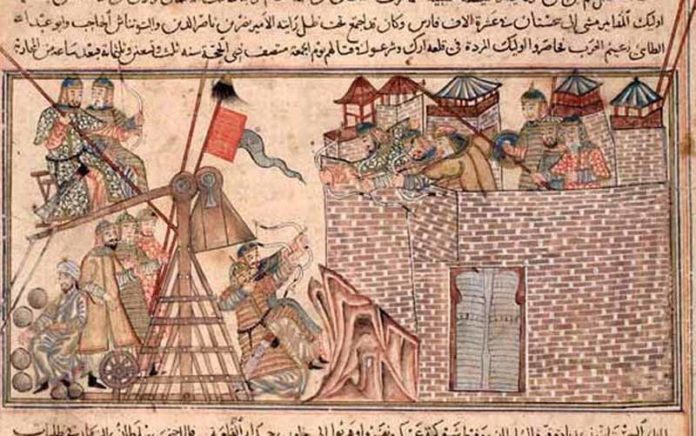The pastoral-nomadic Mongols, also known as the Tatars, were the most powerful military force in pre-modern times. Though they originated in northern Mongolia, near Lake Baikal, they eventually expanded to create the largest land-based empire in world history stretching from Korea to Hungary to Egypt. The Mongol empire originated with Chinggiz Khan who began building the state around 1206. Chinggiz Khan was born as Temujin in the Kentei province around the year 1165. He grew up in Mongolia, which at that time was grouped into loose tribal confederations. The events of Temujin’s childhood gave him a harsh political and military apprenticeship, which prepared him for the events of his later life when he would become Chinggiz Khan or “Universal Ruler.”
The Rise of the Great Khan
In 1206, a great kuriltia, assembly of steppe tribes, met and declared Chinggis Khan ruler of all the Mongol tribes, which he had worked hard to unite. Chinggis Khan undertook many military campaigns including his conquest of North China and Tibet, which concluded in 1215 when he took Beijing. In fact, he was able to take control of all of central Asia during a two year period from 1218 to 1220. Chinggis Khan’s last campaign took place in 1226. It was aimed at the subjection of the region of Hsia-hsia. Unfortunately, this conflict would come to an abrupt end with Chinggis Khan’s death in 1227. After his death, Chinggis Khan’s son Ogodei took power over Mongol lands and continued the process of expansion. By 1270, the Mongols had conquered Korea, southern China, and established the largest, continuous land empire in history.
One of the main reasons for Chinggis Khan’s success in forming his empire was the extensive fighting ability of Mongol warriors; particularly Mongol horsemen. Like all pastoral-nomadic peoples, the Mongol’s way of life gave them an added advantage in warfare. Their experience controlling large herds taught them necessary military organization skills. Furthermore, experience herding and traveling upon horses led to the implementation of the Mongols’ powerful cavalry. As pastoral-nomads, they learned to ride on horseback at a very young age, and by the time they were old enough for battle could fire compound bows while mounted. Other Mongol weapons used by the cavalry included the saber, which they used to decapitate enemies.
Chinggis Khan had a great impact in reorganizing the already powerful Mongol military. He changed the system of tribal allegiances into a vast national army whose purpose was the expansion and protection of Mongol territory as a whole. Furthermore, he instituted the decimal system of military organization. Under this system, units were organized into groups of base ten. If one-ninth of a unit did not show up for battle, the entire unit would be put to death. This encouraged loyalty and obedience within the Mongol army, which was a major factor in the Empire’s success.
The Origins of the Plague
The Mongols had vast control over the area of China, and it is here that the dreaded Bubonic Plague, or Black Death, originated. The plague soon spread over trade routes, which were, at that time, under Mongol control. Unfortunately for the Mongols, the spread of the plague would also lead to a decline of this trade during the 1350s and 1360s. This had a dire impact on the Mongol Empire, particularly in the regions under the control of the Golden Horde. A vast portion of Mongol income came from commercial endeavors, and the decline of trade meant a decline in revenue which supported Mongol cities and their immense, cavalry-based army. In addition to this loss of commercial foundation, Mongol cities also experienced vast population losses as both common citizens and military leaders succumbed to the fatal disease. The effects of the Black Death combined with other factors, such as civil wars including a large rebellion led by Timerlane, to weaken the Mongol Empire and bring about its decline and eventual collapse.
Impact of the Black Death
While the Black Death was bringing about the decline of the Mongol Empire in the East, its destruction in western Europe had led to a new era of learning and discovery; the Renaissance. Western Europe had previously been spared attack by the Mongols because it had nothing of value that the Mongols could not receive from Eastern Europe. Furthermore, the geography west of Hungary lacked prairie lands and was unsuitable for the pastoral-nomadic Mongols. Thus, during the period following the spread of the Black Death, Western Europe was able to expand in power and influence. This would eventually lead to a permanent shift of world power from Eastern to Western Eurasia.
In analyzing the events of the Mongol Empire and their relation to the Black Death, it becomes clear that the Mongols were in part responsible for the spread of this deadly epidemic. However, the Mongols themselves were not exempt from the adverse effects of this disease. In fact, this disease would play a significant role in the downfall of the greatest land empire in history. Furthermore, Black Death was a leading cause in the rise of Western Europe as a world power; a rise that would not have taken place if the Mongols had not spared this region of Eurasia. Thus, it is clear to the historian that during this era of world history the Mongols of the east intertwined with the events of the West to shape the world into what we know today.








